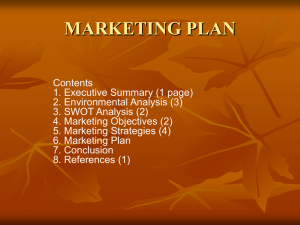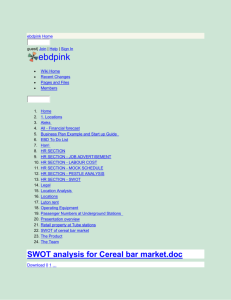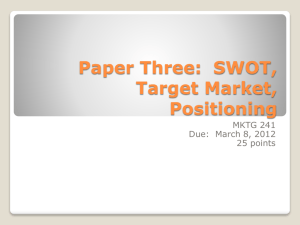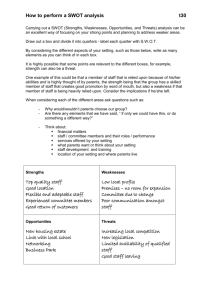Running Header: SWOT ANALYSIS Objective 2a: Professional Entry
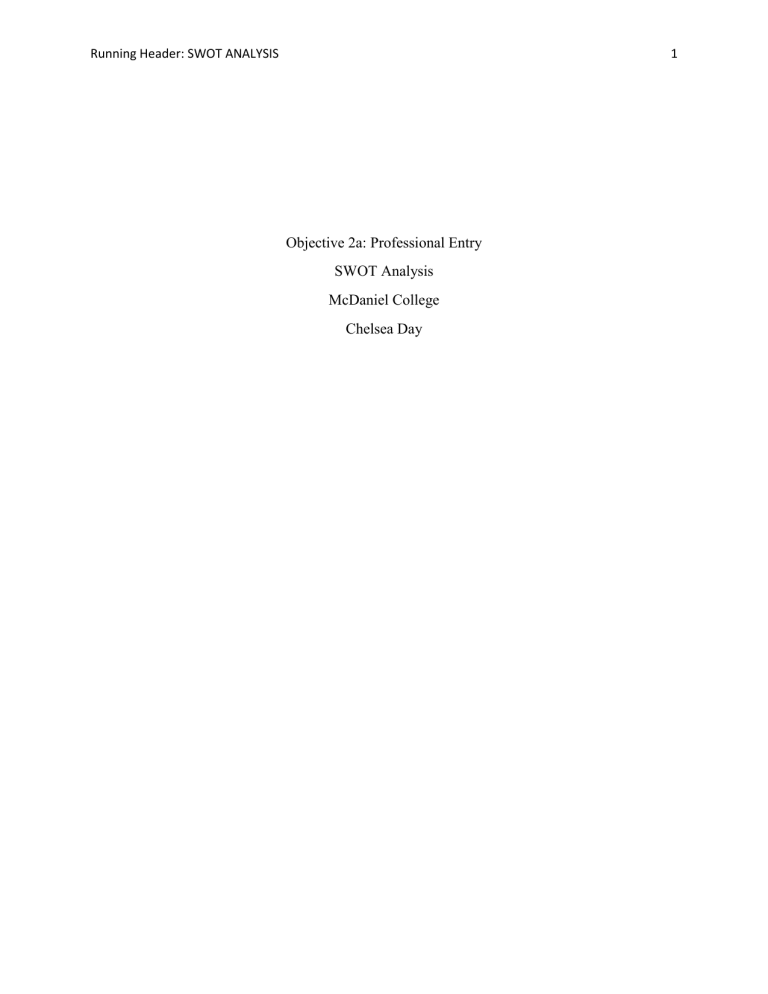
Running Header: SWOT ANALYSIS
Objective 2a: Professional Entry
SWOT Analysis
McDaniel College
Chelsea Day
1
Running Header: SWOT ANALYSIS
One major skill McDaniel Colleges Human Resource Development program requires for all proficient graduate students it the ability to collect and use data in order to better
2 serve an organizations mission and employees. In order to be a successful HRD professional one must be able to be proactive and use all sources of information to not only make sure and organization is meeting its goals but finding new and more proficient ways to increase productivity and reduce organization risks. During my internship at Bowie State University’s
Training department I was able to successfully perform this skill by collecting data about the university and its staff in order to create a Strength-Weakness-Opportunity-Threat analysis of the organization current training program. This professional artifact was provided to the Training and Professional development coordinator for the organization so that it may be used to help improve the program to gain participation in the Universities training courses, which is now mandated by the Universities leadership.
During my internship at BSU I was provided access to the Universities training programs, their attendance data, policies and their turnover rate. The organization was suffering from high turnover rate and looking to transform its professional development training program in order to change several aspects of the organization. For one the organization was looking to change the culture of the organization by creating an environment more which changes the way it’s educational staff views students by adding a customer service element to their profession. In order to discover how to best support the BSU’s new initiative to implement cultural change through training, it was first necessary to find how successful the program had been thus far. In order to do this I first collected all data pertaining to the past three years of training courses and
Running Header: SWOT ANALYSIS employee attendance. As the initiative was new, it was important to compare previous year’s
3 participation in order to see if the initiative was being successful. I also reviewed the training courses with most attendance to see if the customer services courses were being utilized. After reviewing this data, I conducted interviews of the HR staff of the organization to gain a better understanding of the organizations culture.
This process allowed me to collect qualitative and quantitative data which I used to create a SWOT analysis. Through this analysis I discovered that in order to institute the type of organizational change sought after by leadership, that the organizations leadership must take a more active role. Employees of the organization were not being motivated by leadership to institute change, there were no risks or rewards to participating in training courses and making organization change.
SWOT analysis, while not a perfect tool can be extremely valuable in that it establishes key competencies with an organization (Coman & Roman, 2009). During my data collection I requested several times to be able to structure and distribute a climate survey to organization employees in order to gain more data into employee’s interests and opinion of the organization training courses and programs. The organizational and culture changes leadership wanted to establish is a new phenomenon occurring in the high education industry (Horn,20140).
I felt it would be a valuable asset to survey the organizations employees of their opinions on the current state of the organization and possible changes. Unfortunately leadership was fearful of the impact that a survey would have on its staff. One of the benefits of a SWOT analysis is that I was able to use it to establish concrete competencies and weakness through the available information. The information provided was valid and available and was still valuable because it revealed a large amount about the organization. Without surveying employees, the limited
Running Header: SWOT ANALYSIS enrollment in training courses proved that even when mandated to participate in training, employees were reluctant to participate in training.
4
SWOT analysis in this situations and similar situations would be my chosen method to begin data collection and analysis as opposed to the need gap method. This is because while the organization was aware that they had several organizational issues they were unsure of where their weaknesses were. Through a SWOT I was able to catalog each aspect of the organization. It would be useful to use a need gap analysis further along to asses specific needs to help strengthen organizational weaknesses. Need-gap analysis has been successfully used to addresses the quality of customer service for other organization and has been successful in establishing step by step process in order to fill the needs to make necessary improvements (Tsai, 2010). BSU had tried to fill their need of lack of customer service with training but was unsuccessful in doing so. It is due to this lack of success that I choose to perform a SWOT analysis to identify why the training initiative was not being successful.
After further review of my SWOT after the fact, I discovered that leadership did not actively participate in any training. Reviewing the organizations data and leadership through
Fielders Contingency Theory, it was clear that leadership did not establish an environment in which employees were motivated to change or had a relationship with leadership which would have made them feel influenced by leadership.
Running Header: SWOT ANALYSIS
References
Coman, A., & Ronen, B. (2009). Focused SWOT: diagnosing critical strengths and weaknesses.
International Journal Of Production Research, 47(20), 5677-5689. doi:10.1080/00207540802146130
Horn, M. (2014, July 10). Unbundling And Re-bundling In Higher Education.
5
Tsai, W., Hsu, W., & Chou, W. (2011). A Gap Analysis Model For Improving Airport Service
Quality. Total Quality Management & Business Excellence, 1025-1040.
